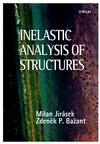Descripción de la obra
The modeling of mechanical properties of materials and structures is a complex and wide-ranging subject. In some applications, it is sufficient to assume that the material remains elastic, i.e. that the deformation process is fully reversible and the stress is a unique function of strain. However, such a simplified assumption is appropriate only within a limited range, and in general must be replaced by a more realistic approach that takes into account the inelastic processes such as plastic yielding or cracking.
This book presents a comprehensive treatment of the most important areas of plasticity and of time-dependent inelastic behavior (viscoplasticity of metals, and creep and shrinkage of concrete). It covers structural aspects such as:
* incremental analysis
* limit analysis
* shakedown analysis
* optimal design
* beam structures subjected to bending and torsion
* yield line theory of plates
* slip line theory
* size effect in structures
* creep and shrinkage effects in concrete structures.
The following aspects of the advanced material modeling are presented:
* yield surfaces for metals and plastic-frictional materials
* hardening and softening
* stress-return algorithms
* large-strain formulations
* thermodynamic framework
* microplane models
* localization of plastic strain.
Inelastic Analysis of Structures is a textbook for basic and advanced courses on plasticity, with a slight emphasis on structural engineering applications, but with a wealth of material for geotechnical, mechanical, aerospace, naval, petroleum and nuclear engineers. The text is constructed in a very didactical way, while the mathematics has been kept rigorous.
